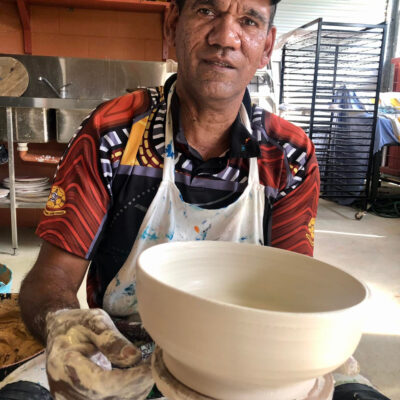
Wayne Connolly
UMI Arts LimitedKuku Yalanji / Kuku Taipan
__________________________________________________________________________________________________________
Wayne is an emerging Indigenous artist from Yarrabah, Queensland. His artistic practice is heavily influenced by his rich cultural heritage and family history, which spans multiple Indigenous groups and regions. His paternal grandmother, Bessie Yeatman, was Kuku Yalanji and Kuku Taipan from Wujul Wujal and Maryvale. She married Stanley Connolly. Wayne’s paternal grandfather, Claude Ponto, came from Kowanyama to Ngukurr (Roper River). Claude was a renowned tracker whose exceptional skills led him to be taken by the police from the Mitchell River to Victoria to assist in tracking the notorious bushranger Ned Kelly. One of Claude’s hand-carved and polished trophy shells, showcasing his remarkable legacy, is now housed in the National Museum of Australia.
Wayne’s family history is also marked by stories of resilience and survival. His grandmother was forcibly taken as part of the Stolen Generation, a tragic chapter in Australian history. His mother, Valmai Connolly, belongs to the Gumbaynggirr language group of New South Wales. His ancestors evaded the heartlessness of colonization by fleeing from Nambucca to Wallaga Lake Aboriginal Mission. Wayne’s parents met in Sydney while his mother was studying nursing and eventually settled in Yarrabah, where they raised their five children.
Wayne’s father, Wayne Connolly Sr. was a priest at the Saint Albans Anglican Church, which meant the family moved frequently during his childhood. These experiences, along with his love for family and regular travels to visit relatives across the country, fostered in Wayne a deep appreciation for his cultural heritage and the natural world. Wayne primarily focuses on painting animals, fish, and the natural landscapes vital to his life. His work captures the essence of the land and sea surrounding Yarrabah and the stories shared by the community’s elders. Often, Wayne’s art reflects experiences of traditional living, including hunting, fishing, and gathering bush food—activities that continue to play an important role in his everyday life. His work is not only a personal exploration of his cultural identity but also serves as a celebration of the beauty and richness of Yarrabah’s natural environment.



